The
Sporting Breeds
page 2
page 3 |
|
American Water Spaniel
Although a very rare breed, the American Water Spaniel has its own
state-wide fan club as the State Dog of Wisconsin! A truly dual-purpose
dog, bred for companionship and top-notch retrieval ability, the AWS is
active, muscular and medium in size. This breed’s unique coat can be
solid liver, brown or dark chocolate and ranges from marcel (uniform
waves) to closely curled.

A Look Back
The American Water Spaniel developed primarily in the Great Lakes region
of the United States in the mid 1800’s, with ancestors that include the
Irish Water Spaniel and Curly-Coated Retriever. They were the first breed
developed in this country as an all-around hunter that could retrieve from
boats. Breed enthusiasts kept the AWS out of the show ring for a short
time in fear of ruining his reputation as a hunter, but the breed became
recognized by the AKC in 1940.
Right Breed for You?
An excellent sporting and family dog, the American Water Spaniel possesses
great energy and eagerness for the hunt yet is controllable in the field.
Similarly, he loves his daily exercise, but also enjoys just hanging out
with his family. Friendly and eager to please, the AWS responds well to
obedience training. His short coat requires regular brushing. |
Barbet
An archetypic water dog of France, the Barbet is a rustic breed of
medium size and balanced proportions who appears in artwork as early as
the 16th century. In profile, the Barbet is slightly rectangular with a
substantial head and long, sweeping tail. He has a long, dense covering
of curly hair and a distinctive beard. An agile athlete, the Barbet has
been used primarily to locate, flush, and retrieve birds. He has a
cheerful disposition and is very social and loyal. The defining
characteristic of this rustic, medium-sized bird dog is the dense curly
coat that covers him from the top of his large, broad head to the tip of
his curving tail. The coat comes in shades of black, gray, brown, or
fawn, sometimes with white markings. The breed's delightfully shaggy
coat and amiable nature creates the impression of a Muppet come to life,
but the Barbet is a strong, solidly-built dog bred for centuries to be a
keen hunter and tireless swimmer. Barbets are very intelligent and learn
new things quickly. They have a calm nature and are easy to live with as
long as their exercise needs are being met.
A Look Back
The Barbet is more than a versatile gun dog. It is a joyful, smart,
loving, and devoted breed. The Barbet was originally a water dog and was
primarily used in France for hunting water game, as mentioned in 16th
century scripts. Other references to the breed are throughout history,
doing various jobs with historical lineage, always referenced with
respect and admiration. |
| Boykin Spaniel
The official State Dog of South Carolina, the Boykin Spaniel is a
medium-sized, all-around hunting dog with a cheerful, energetic
personality. Possessing a rich, chocolate-brown coat and charm to spare,
the Boykin is a favorite of hunters due to its willingness to work all
day as well as its smaller size, which allows the hunter to lift both
dog and duck into the boat at the same time!
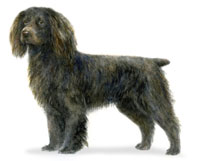 A Look Back A Look Back
In the early 1900s, a small dog was found wandering near a church in
Spartanburg, South Carolina, and one of the people attending services
there, a Mr. Alexander L. White, took the dog home as a pet. Mr. White
sent the dog to his hunting partner Mr. L. Whitaker Boykin of the Boykin
community just outside Camden, South Carolina and the little stray
developed into a superb turkey dog and waterfowl retriever.
Right Breed for You?
The Boykin has the stamina to stay by its owner’s side during a full
day of work, so it fits in best with an active family. The breed also
thrives on companionship, enjoying the company of children and other
dogs. Its coat requires only minimal maintenance beyond a weekly
brushing and occasional bathing. |
|
Brittany
The Brittany is a medium-sized, leggy, dual-purpose dog, equally
suited for sport and companionship. According to
AKC®
Registration Statistics, it has surged in popularity in the last 50
years due to its talents as both a hunting and show dog. Originally
called the Brittany Spaniel, it is now referred to simply as the
Brittany, as its hunting style more closely resembles that of pointing
breeds. Its dense, flat or wavy coat can be orange and white or liver
and white in either clear or roan patterns.
A Look Back
The Brittany was named for the French province where it originated, but
records of its development are largely lost. There is a great deal of
resemblance between the Brittany and Welsh Springer Spaniel, which leads
many people to believe that the two breeds share the same ancestors. It
is possible that native Brittany spaniels mated with English pointing
dogs around 1900, intensifying their hunting prowess in the process.
Right Breed for You?
The Brittany is strong, quick and agile, requiring exercise and activity
to occupy his body and mind. He is a happy and alert dog who possesses
willing attitude. Regular brushing is important, but their shorter coats
need minimal maintenance. |
|
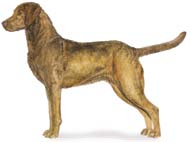 Chesapeake Bay Retriever Chesapeake Bay Retriever
Developed along the Chesapeake Bay and named the state dog of
Maryland, the Chesapeake Bay Retriever is a truly American sporting
breed and the toughest water retriever. He is a strong, powerfully built
medium-sized breed with yellowish or amber eyes and a distinctive coat -
a short, harsh, wavy outercoat with a dense fine wooly undercoat. His
color can be brown, sedge or deadgrass and must be as close to that of
his working surroundings as possible.
A Look Back
In 1807, an English brig shipwrecked off the coast
of Maryland and two Newfoundlands were rescued from the cargo. When bred
to local retrievers, including the English Otter Hound, Flat-Coat
and Curly-Coated Retriever, the "Chessie" type developed. Bred
to work on land and water, the Chesapeake Bay Retriever originally
hunted waterfowl in rough and icy waters, often retrieving several
hundred birds per day.
Right Breed for You?
The Chesapeake is a happy and intelligent breed whose courage, working
ability and love of water mesh best with active, outdoor-loving
families. His coat is short, but owners must brush and maintain it
regularly, as both the outercoat and undercoat contain oils for
protection in harsh conditions. |
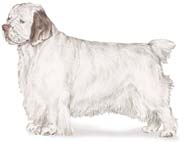 Clumber
Spaniel Clumber
Spaniel
One of the original nine breeds registered by
the AKC, the Clumber Spaniel’s long and low build is particularly
unique among spaniels. Although not as speedy as other sporting dogs,
the Clumber will work all day, trotting along in his signature slow,
rolling gait. He may appear dignified and pensive, but he possesses
great enthusiasm for both work and play. The breed possesses a beautiful
white coat and may have lemon or orange-colored markings.
A Look Back
Some doubt exists about the origin of the Clumber Spaniel, but most
believe the breed originated in 18th-century France with ancestors such
as the Basset Hound and early Alpine Spaniel. The Clumber was prized for
his ability to hunt in heavy cover and his quiet style, which allowed
him to come up very close to the game. The breed received its modern
name when a large French kennel moved Duke of Newcastle’s Clumber Park
at the start of the French Revolution in an effort to save its dogs.
Right Breed for You?
Playful and loving, the Clumber Spaniel fits in well with families and
other animals. They enjoy daily walks, but they are not for those who
want a jogging partner. Clumbers shed moderately year-round and tend to
slobber and drool more than other breeds. An intelligent and independent
thinker, the Clumber responds best to positive training. |
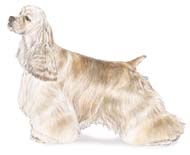 Cocker
Spaniel Cocker
Spaniel
Exhibited in the US since the 1880s, the Cocker
Spaniel remains one of the most popular breeds according to AKC®
registration statistics. The Cocker has a sturdy, compact body and a
silky, flat or wavy coat. He is a merry, well-balanced dog that is
capable of considerable speed and great endurance. Cocker Spaniels can
be black, black with tan points, parti-colored or any solid color other
than black (ASCOB).
A Look Back
As far back as the 14th Century there is mention of the Spanyell, which
came to be divided into water and land spaniels. "Cockers" are
the smallest of the spaniels and the Sporting Group. The American Cocker
has evolved somewhat differently in appearance from the breed now
recognized as the English Cocker Spaniel. His desire to hunt renders him
a capable gun dog; he covers territory speedily, flushing game and
retrieving only when under command. He takes to water readily.
Right Breed for You?
Despite their small size, the Cocker Spaniel is still an active Sporting
breed that needs daily exercise. Regular brushing and a trim every few
months helps keep the coat free of mats. Cockers are intelligent, gentle
dogs that thrive as part of a family. |
 Curly-Coated
Retriever Curly-Coated
Retriever
Distinguished by its coat of small, tight,
water-resistant, crisp curls, the Curly-Coated Retriever is a strong,
robust and agile breed. Developed to be a multi-purpose hunting
retriever, the Curly will work for as long as there is work to be done,
retrieving game in the heaviest of cover and iciest of waters. The
breed’s curly coat can be black or liver in color.
A Look Back
Although the Curly’s origins are unclear, he is one of the oldest of
all retriever breeds, thought to have descended from the English Water
Spaniel, the St. John’s Newfoundland, the retrieving setter and the
Poodle. Developed in England as both a waterfowl retriever and upland
game hunter, this breed was a favorite of English gamekeepers for his
innate field ability, courage and perseverance.
Right Breed for You?
An energetic and intelligent dog, the Curly-Coated Retriever is an
excellent companion, but requires training and daily exercise or a job
to keep him from becoming bored and destructive. One of the more
independent retriever breeds, the Curly may appear somewhat aloof, but
is always willing to please. Their coat is easy to care for, requiring
only occasional bathing. |
 English
Cocker Spaniel English
Cocker Spaniel
An active sporting dog, the English Cocker
Spaniel’s compact, solid body practically vibrates with energy and
enthusiasm, particularly when at work in the field. Although known for
its soft, melting spaniel expression, the breed is a tough worker,
capable of covering ground effortlessly and penetrating the densest of
cover. His coat can be solid-colored (black, liver or shades of red) or
parti-colored, including ticking or roaning.
A Look Back
One of the oldest types of land spaniel known, the Cocker descended from
the original spaniels of Spain. They were used to hunt in dense cover,
flushing and retrieving game. In 1935, The English Cocker Spaniel Club
of America was formed in the United States to promote the interest of
the English Cocker and differentiate it from the American-type Cocker
that was emerging. The English Cocker was recognized as separate from
the American Cocker Spaniel by the AKC in 1946.
Right Breed for You?
Merry and affectionate, the English Cocker Spaniel is an excellent
family companion due to its even disposition and trainability. Whether
working in the field or at home lounging on their owner’s bed, their
tails rarely stop wagging. The breed can live in any environment
provided it receives daily exercise. Their medium-long coat does take
some care, including brushing and regular stripping or clipping. |
 English
Setter English
Setter
A graceful, elegant gundog, the English Setter
today excels in the show, obedience and agility rings as well as in the
field. Although similar in function to the Irish and Gordon
Setters, the English is a distinct breed, differing personality and
appearance. Their beautiful feathered coat is white with an
intermingling of darker hairs resulting in markings called "belton."
Belton markings can be orange, blue (white with black markings),
tricolor (blue belton with tan points), lemon and liver.
A Look Back
One of the oldest gundog breeds, the English Setter was developed in
England more than 400 years ago. Believed to have developed from Spaniel
stock, the breed was originally called a Setting Spaniel. Before the use
of firearms, this "Setting Spaniel" would find the birds and
then crouch down on its front legs or "set" to allow the
hunter to throw a net over the game. When guns became widely used, a
more upright pointing stance was bred into the Setter so he could be
more easily seen.
Right Breed for You?
This gentle, affectionate family dog loves to be with its people and
does not thrive when isolated in a yard or kennel. Athletic and
energetic, they also require daily vigorous exercise either on leash or
in a fenced area. Their beautiful, feathered coat requires regular
maintenance, including brushing and clipping. |
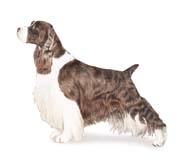 English
Springer Spaniel English
Springer Spaniel
The English Springer Spaniel has been endowed
with style, enthusiasm, and an "eager to please" quality
common to most spaniels. He is recognized for his ability to keep going
and going under adverse hunting conditions, which is partly due to his
medium-sized, powerful body. He has long, hanging ears and a moderately
long coat that can be black or liver with white, blue or liver roan, and
tricolor.
A Look Back
English Springer Spaniels and Cocker Spaniels were originally born in
the same litters; the smaller "Cockers" hunted woodcock while
their larger littermates were utilized to flush, or "spring,"
game. In 1902 the Kennel Club of England recognized the English Springer
Spaniel as a distinct breed (separate from English Cockers). The
Springer Spaniel became even better known in North America after 1924,
when the English Springer Spaniel Field Trial Association was formed and
field trials were started for the first time.
Right Breed for You?
Cheerful and affectionate, Springers love their families and like to
stick close to their owners. They make excellent house pets, but require
daily exercise and need regular brushing and trimming to keep their
coats neat and free of mats. |
(page
information from the AKC website)

|